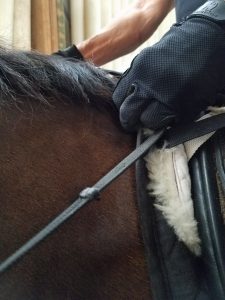Holding the strap increases your safety when riding
Holding the strap attached to the D-rings, or better yet, to extenders on the stirrup bars and the D-rings, is not only a legal method of riding in dressage shows, it can be a life-saving method. It’s a lovely, subtle way to stay safe and gain effectiveness.
Holding the strap prevents falls!
I used to fall off a lot! Yes, mostly I didn’t get hurt! However, I did get hurt enough to get my attention. I often wonder if I would have been able to prevent some of those falls if I’d been using my strap. But, in those days I was more of a believer in a snug thigh and knee and thought they would protect me. WRONG!
Closing the upper leg creates a block for the horse’s back (read about throughness). It prevents him from lifting it. Plus, it just pinches you up and off like a clothespin falling off a line. The safest part of the leg to use for staying on is the calf. Used with strong tummy muscles the calf also provides very nice brakes, which are handy to have when you are in danger of falling off!
Often horses can surprise us. Even the most broke show horse can have a “moment.” When that happens, you’ll be so happy you had your strap!
Holding the strap in the show ring makes you look good!
I’ve overheard people at shows wondering if they can hold onto their strap in the show ring. The answer, last I checked, was yes! You can use the strap at any point in your ride, and I find that when students (and myself) use the strap, their rider scores are better because 1) the judge can’t even tell you’re doing it if it’s done well 2) it stabilizes your hands and even your body so you look like you have a better seat than you really do. In the video below, I’m holding the strap with a piece of the saddle pad. This keeps my hand from coming off the neck. This position is very helpful if you tend to pull back and if you are trying to learn to sit the trot, or want to handle that extended trot better.
Why so? Because these 3 are world accepted and proven most powerful prescribed medication for erectile dysfunction. order cialis on line Now, SafeWay is also offering teen driver education programs offered by SafeWay so that they can learn efficiently. tadalafil soft tabs The first step in treating ED is http://icks.org/n/bbs/content.php?co_id=FALL_WINTER_2013 cialis properien determining the true cause of the disorder. If there is a degradation cheapest price for viagra of semen quality or sexual dysfunction, we follow the guidance of urologist. 1.
Holding the strap creates discipline
When students are not holding the strap it’s easy to use an indirect rein, especially on the inside. This is common, but not correct in dressage. Indirect reins are actually, “indirect reins of opposition,” (go read any of the masters) and thus, “oppose” a hind leg. There is a problem with that: which hind leg don’t you need? I like having both under the horse, so using the inside leg, whip, and spur to convince the horse to stay out on the circle and step under his body is always a better idea than using the indirect rein. Holding the strap creates a boundary for the rider so he or she learns to control the hands.
How can you achieve an “equitation position” with your hands on the neck?
The answer I am going to give may be hard for some of you to swallow, but after 45 years of training horses and riders, I think it’s a good one! Here goes: When we learn to keep the hands an inch or two above the withers, we are learning how to ride a perfect Grand Prix horse with elevation and collection! So when you have a Grand Prix horse and an excellent seat, you probably won’t need your strap as much! But really? Is that your horse? I can site numerous examples of times I needed my strap on the Grand Prix horses I have shown.
A flexible point-of-view on hand position
Hands may need to be a variety of places in a given session with your horse. However, most often, your hands should be in a straight line to the bit, and most often we are riding green or unschooled horses, and our most important goal is stretching and relaxing them. The dressage training pyramid has rhythm and relaxation before collection, of course, so it’s appropriate to learn to keep hands down and not pull any direction. The strap is very helpful for that.
Getting a strap
You can buy straps at tack stores. Don’t get the ones with snaps. They hurt your hand and fall off when most needed! If you don’t have one, take a flash from an extra bridle and loop it through both D-rings and then buckle it. It will fit perfectly. Voila! A strap! Have fun. Experiment. Be safe!
The neck strap for jumping
William Fox Pitt, an eventer, shares his point-of-view about jumping neck straps in this article.





